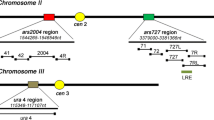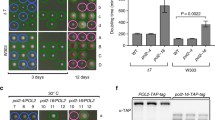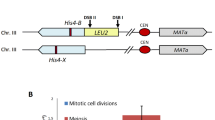Summary
In an attempt to identify proteins involved in the initiation of DNA replication, we have isolated a series of Saccharomyces cerevisiae mutants in which the function of putative replication origins is affected. The phenotype of these Rar- (regulation of autonomous replication) mutants is to increase the mitotic stability of plasmids whose replication is dependent on weak ARS elements. These mutations are generally recessive and complementation analysis shows that mutations in several genes may improve the ability of weak ARS elements to function. One mutation (rar1-1) also confers temperature-sensitive growth, and thus an essential gene is affected. We have determined the DNA sequence of the RAR1 gene, which reveals an open reading frame for a 48.5 kDa protein. The RAR1 gene is linked to rna1 on chromosome XIII.
Similar content being viewed by others
References
Biggin MD, Gibson TJ, Hong GF (1983) Buffer gradient gels and 35S as an aid to rapid DNA sequencing. Proc Natl Acad Sci USA 80:3963–3965
Boeke JD, LaCroute F, Fink GR (1984) A positive selection for mutants lacking orotidine-5′-phosphate decarboxylase activity in yeast: 5-fluoro-orotic acid resistance. Mol Gen Genet 197:345–346
Bouton AH, Smith MM (1986) Fine-structure analysis of the DNA sequence requirements for autonomous replication in yeast. Mol Cell Biol 6:2354–2363
Carle GF, Olson MV (1985) An electrophoretic karyotype of yeast. Proc Natl Acad Sci USA 82:3756–3760
Celniker SE, Sweder K, Srienc F, Bailey JE, Campbell JL (1984) Deletion mutants affecting autonomously replicating sequence ARS1 of S. cerevisiae. Mol Cell Biol 4:2455–2466
Clarke L, Carbon J (1980) Isolation of a yeast centromere and construction of functional small circular chromosomes Nature 287:504–509
Deininger PL (1983) Random subcloning of sonicated DNA: application to shotgun DNA sequence analysis. Anal Biochem 129:216–223
Dotto GP, Zinder ND (1984) Reduction of the minimal sequence for initiation of DNA synthesis by qualitative or quantitative changes of an initiator protein. Nature 311:279–280
Fitzgerald-Hayes M, Clarke L, Carbon J (1982) Nucleotide sequence comparison and functional analysis of yeast centromere DNAs. Cell 29:235–244
Hieter P, Mann C, Synder M, Davis RW (1985) Mitotic stability of yeast chromosomes: a colony colour assay that measures nondisjunction and chromosome loss. Cell 40:381–392
Ito H, Fukada Y, Murata K, Kimura A (1983) Transformation of intact yeast cells treated with alkali cations. J Bacteriol 153:163–168
Jones KA, Kadonaga JT, Rosenfeld PJ, Kelly TJ, Tjian R (1987) A cellular DNA-binding protein that activates eukaryotic transcription and DNA replication. Cell 48:79–89
Kearsey SE (1983) Analysis of sequences conferring autonomous replication in baker's yeast. EMBO J 2:1571–1575
Kearsey SE (1984) Structural requirements for the function of a yeast chromosomal replicator. Cell 37:299–307
Kearsey SE (1986) Replication origins in yeast chromosomes. Bioassays 4:157–161
Kogoma T, von Meyenberg K (1983) The origin of replication oriC, and the dnaA protein are dispensable in stable DNA replication (sdrA) mutants of E. coli K12. EMBO J 2:463–468
Kozak M (1983) Comparison of initiation of protein synthesis in prokaryotes, eukaryotes and organelles, Micribol Rev 47:1–45
Lipman DJ, Pearson WR (1985) Rapid and sensitive protein similarity searches. Science 227:1435–1441
Maniatis T, Fritsch EF, Sambrook J (1982) Molecular cloning: A laboratory manual. Cold Spring Harbor Laboratory, Cold Spring Harbor, New York
Maine GT, Sinha P, Tye B-K (1984) Mutants of S. cerevisiae defective in the maintenance of minichromosomes. Genetics 106:365–385
Morris DW, Noti JD, Osborne FA, Szalay AA (1981) Plasmid vectors capable of transferring large DNA fragments to yeast. DNA 1:27–36
Murray AW, Szostak JW (1983) Pedigree analysis of plasmid segregation in yeast. Cell 34:961–970
Ogawa T, Pickett GG, Kogoma T, Kornberg A (1984) RNaseH confers specificity in the dnaA-dependent initiation of replication at the unique origin of the E. coli chromosome in vivo and in vitro. Proc Natl Acad Sci USA 81:1040–1044
Perkins DD (1949) Biochemical mutants in the smut fungus Ustilago maydis. Genetics 34:607–626
Sachs AB, Bond MW, Kornberg RD (1986) A single gene from yeast for both nuclear and cytoplasmic polyadenylate-binding proteins: domains structure and expression. Cell 45:827–835
Saffer LD, Miller OL Jr (1986) Electron microscopic study of Saccharomyces cerevisiae rDNA chromatin. Mol Cell Biol 6:1148–1157
Sanger F, Nicklen S, Coulson AR (1977) DNA sequencing with chain-terminating inhibitors. Proc Natl Acad Sci USA 74:5463–5467
Sentenac A, Hall B (1982) Yeast nuclear RNA polymerases and their role in transcription. In: Strathern JN, Jones EW, Broach JR (eds) The molecular biology of the yeast Saccharomyces: Metabolism and gene expression. Cold Spring Harbor Laboratory, New York, pp 561–606
Sharp PM, Tuohy TMF, Mosurski KR (1986) Codon usage in yeast: cluster analysis clearly differentiates highly and lowly expressed genes. Nucleic Acids Res 14:5125–5143
Sherman F, Fink G, Hicks JB (1982) Methods in yeast genetics. Cold Spring Harbor Laboratory. Cold Spring Harbor, New York
Staden R (1982) Automation of the computer handling of gel reading data produced by the shotgun method of DNA sequencing. Nucleic Acids Res 10:4731–4751
Staden R, McLachlan AD (1982) Codon preference and its use in identifying protein coding regions in long DNA sequences. Nucleic Acids Res 10:141–156
Stinchcomb DT, Struhl K, Davis RW (1979) Isolation and characterization of a yeast chromosomal replicator. Nature 282:39–43
Struhl K, Stinchcomb DT, Scherer S, Davis RW (1979) High frequency transformation in yeast: autonomous replication of hybrid DNA molecules. Proc Natl Acad Sci USA 76:1035–1039
Wickner RB (1974) Chromosomal and nonchromosmal mutations affecting the “killer character” of Saccharomyces cerevisiae. Genetics 76:423–432
Zaret KS, Sherman F (1982) DNA sequence requirements for efficient transcription termination in yeast. Cell 28:563–573
Author information
Authors and Affiliations
Additional information
Communicated by C.P. Hollenberg
Rights and permissions
About this article
Cite this article
Kearsey, S.E., Edwards, J. Mutations that increase the mitotic stability of minichromosomes in yeast: Characterization of RAR1 . Mol Gen Genet 210, 509–517 (1987). https://doi.org/10.1007/BF00327205
Received:
Issue Date:
DOI: https://doi.org/10.1007/BF00327205




